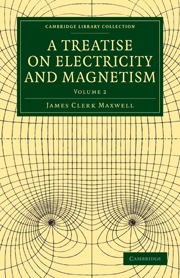Book contents
- Frontmatter
- Contents
- PART III MAGNETISM
- PART IV ELECTROMAGNETISM
- CHAPTER I ELECTROMAGNETIC FORCE
- CHAPTER II MUTUAL ACTION OF ELECTRIC CURRENTS
- CHAPTER III INDUCTION OF ELECTRIC CURRENTS
- CHAPTER IV INDUCTION OF A CURRENT ON ITSELF
- CHAPTER V GENERAL EQUATIONS OF DYNAMICS
- CHAPTER VI APPLICATION OF DYNAMICS TO ELECTROMAGNETISM
- CHAPTER VII ELECTROKINETICS
- CHAPTER VIII EXPLORATION OF THE FIELD BY MEANS OF THE SECONDARY CIRCUIT
- CHAPTER IX GENERAL EQUATIONS
- CHAPTER X DIMENSIONS OF ELECTRIC UNITS
- CHAPTER XI ENERGY AND STRESS
- CHAPTER XII CURRENT-SHEETS
- CHAPTER XIII PARALLEL CURRENTS
- CHAPTER XIV CIRCULAR CURRENTS
- CHAPTER XV ELECTROMAGNETIC INSTRUMENTS
- CHAPTER XVI ELECTROMAGNETIC OBSERVATIONS
- CHAPTER XVII ELECTRICAL MEASUREMENT OF COEFFICIENTS OF INDUCTION
- CHAPTER XVIII DETERMINATION OF RESISTANCE IN ELECTROMAGNETIC MEASURE
- CHAPTER XIX COMPARISON OF ELECTROSTATIC WITH ELECTROMAGNETIC UNITS
- CHAPTER XX ELECTROMAGNETIC THEORY OF LIGHT
- CHAPTER XXI MAGNETIC ACTION ON LIGHT
- CHAPTER XXII ELECTRIC THEORY OF MAGNETISM
- CHAPTER XXIII THEORIES OF ACTION AT A DISTANCE
- INDEX
- Plate section
CHAPTER V - GENERAL EQUATIONS OF DYNAMICS
Published online by Cambridge University Press: 05 July 2011
- Frontmatter
- Contents
- PART III MAGNETISM
- PART IV ELECTROMAGNETISM
- CHAPTER I ELECTROMAGNETIC FORCE
- CHAPTER II MUTUAL ACTION OF ELECTRIC CURRENTS
- CHAPTER III INDUCTION OF ELECTRIC CURRENTS
- CHAPTER IV INDUCTION OF A CURRENT ON ITSELF
- CHAPTER V GENERAL EQUATIONS OF DYNAMICS
- CHAPTER VI APPLICATION OF DYNAMICS TO ELECTROMAGNETISM
- CHAPTER VII ELECTROKINETICS
- CHAPTER VIII EXPLORATION OF THE FIELD BY MEANS OF THE SECONDARY CIRCUIT
- CHAPTER IX GENERAL EQUATIONS
- CHAPTER X DIMENSIONS OF ELECTRIC UNITS
- CHAPTER XI ENERGY AND STRESS
- CHAPTER XII CURRENT-SHEETS
- CHAPTER XIII PARALLEL CURRENTS
- CHAPTER XIV CIRCULAR CURRENTS
- CHAPTER XV ELECTROMAGNETIC INSTRUMENTS
- CHAPTER XVI ELECTROMAGNETIC OBSERVATIONS
- CHAPTER XVII ELECTRICAL MEASUREMENT OF COEFFICIENTS OF INDUCTION
- CHAPTER XVIII DETERMINATION OF RESISTANCE IN ELECTROMAGNETIC MEASURE
- CHAPTER XIX COMPARISON OF ELECTROSTATIC WITH ELECTROMAGNETIC UNITS
- CHAPTER XX ELECTROMAGNETIC THEORY OF LIGHT
- CHAPTER XXI MAGNETIC ACTION ON LIGHT
- CHAPTER XXII ELECTRIC THEORY OF MAGNETISM
- CHAPTER XXIII THEORIES OF ACTION AT A DISTANCE
- INDEX
- Plate section
Summary
553.] In the fourth section of the second part of his Mécanique Analytique, Lagrange has given a method of reducing the ordinary dynamical equations of the motion of the parts of a connected system to a number equal to that of the degrees of freedom of the system.
The equations of motion of a connected system have been given in a different form by Hamilton, and have led to a great extension of the higher part of pure dynamics.
As we shall find it necessary, in our endeavours to bring electrical phenomena within the province of dynamics, to have our dynamical ideas in a state fit for direct application to physical questions, we shall devote this chapter to an exposition of these dynamical ideas from a physical point of view.
554.] The aim of Lagrange was to bring dynamics under the power of the calculus. He began by expressing the elementary dynamical relations in terms of the corresponding relations of pure algebraical quantities, and from the equations thus obtained he deduced his final equations by a purely algebraical process. Certain quantities (expressing the reactions between the parts of the system called into play by its physical connexions) appear in the equations of motion of the component parts of the system, and Lagrange's investigation, as seen from a mathematical point of view, is a method of eliminating these quantities from the final equations.
- Type
- Chapter
- Information
- A Treatise on Electricity and Magnetism , pp. 184 - 194Publisher: Cambridge University PressPrint publication year: 2010First published in: 1873



